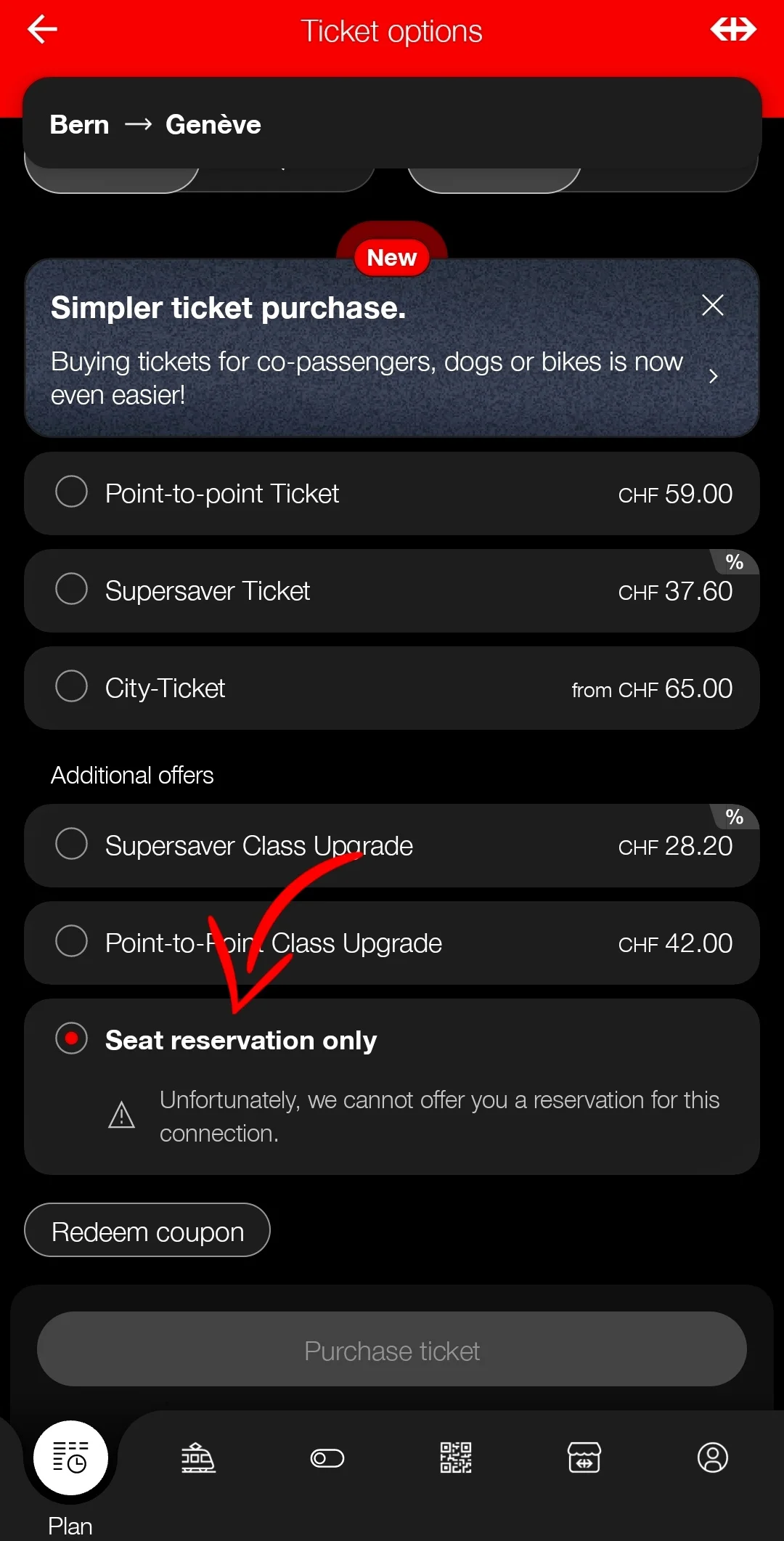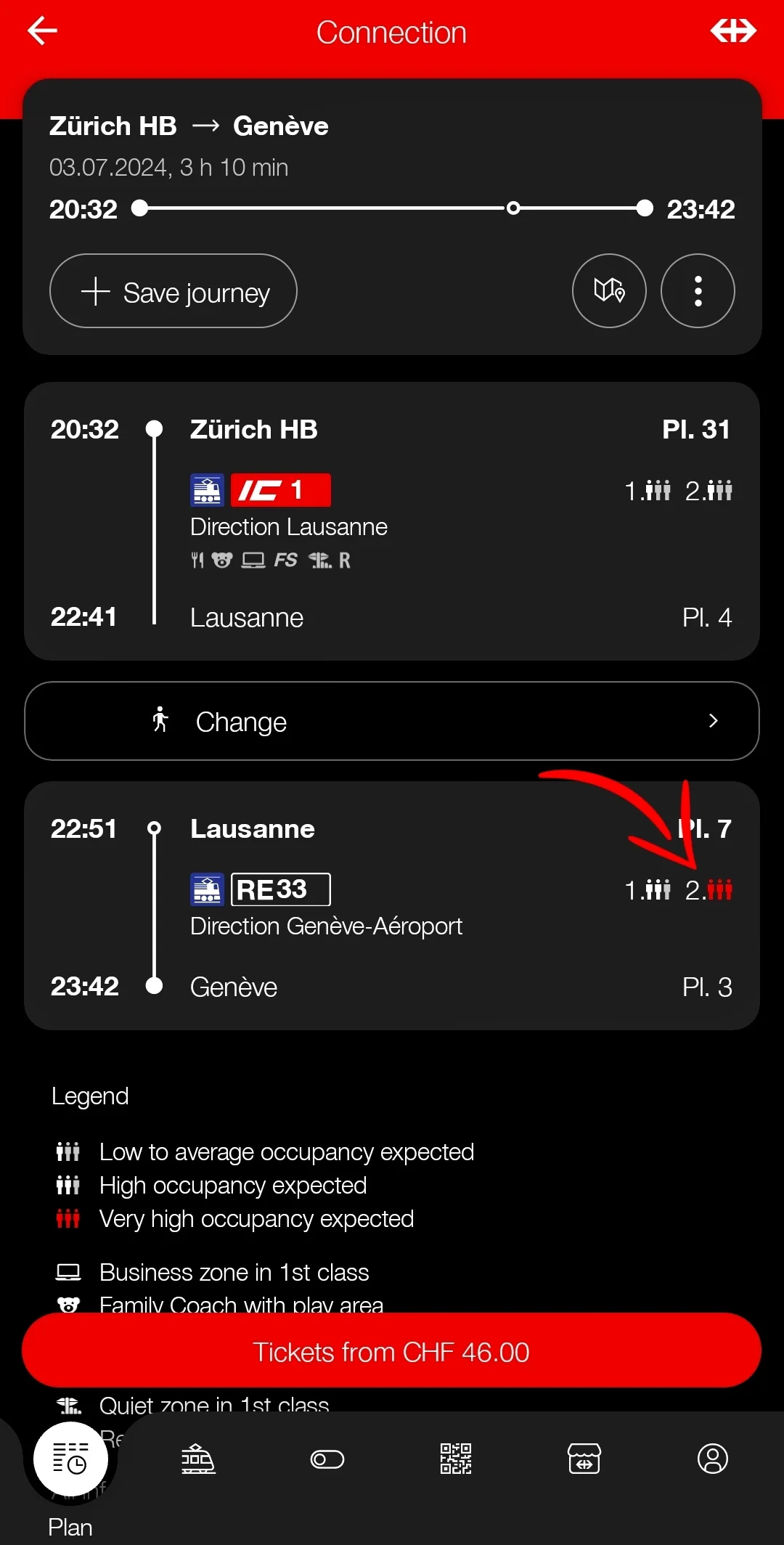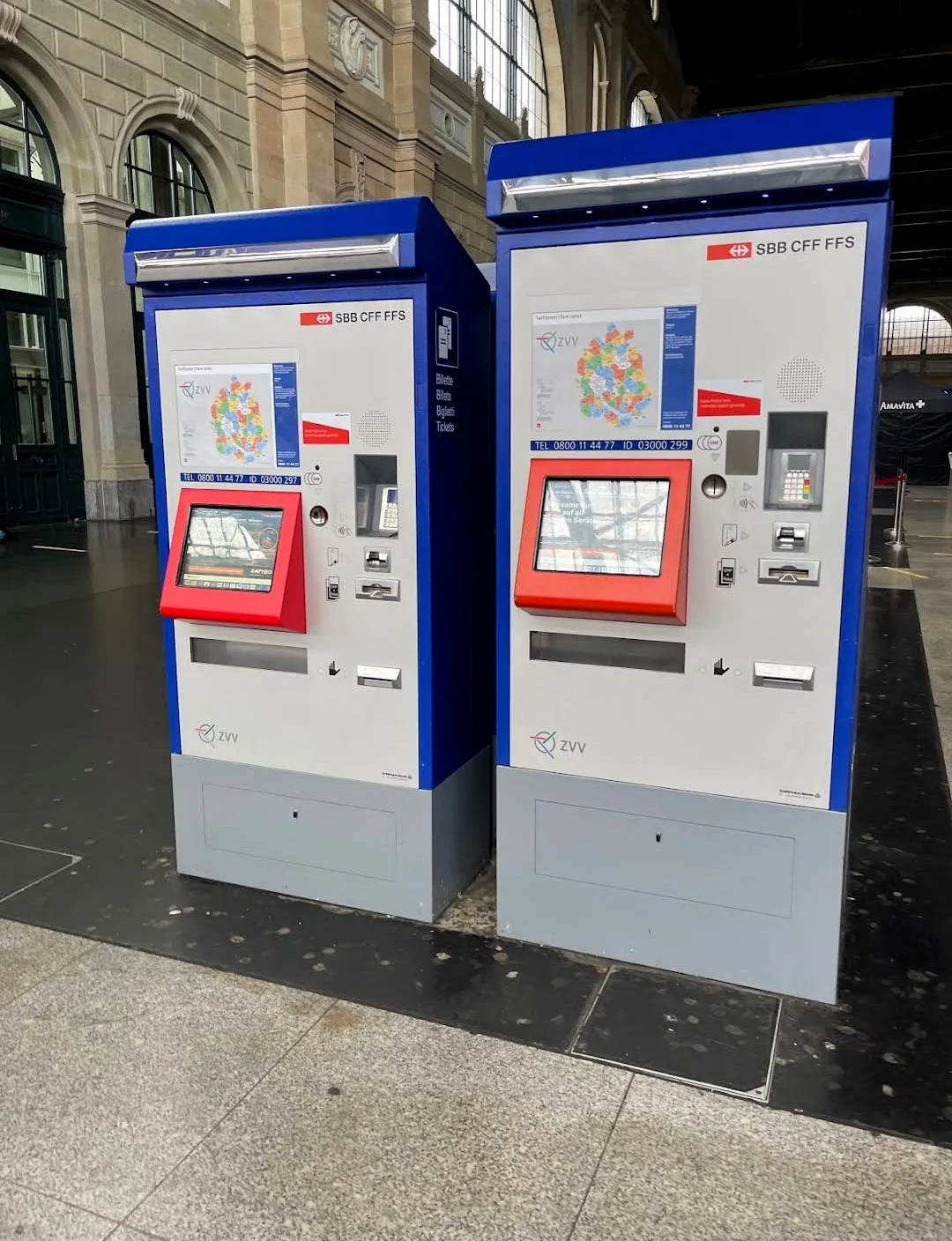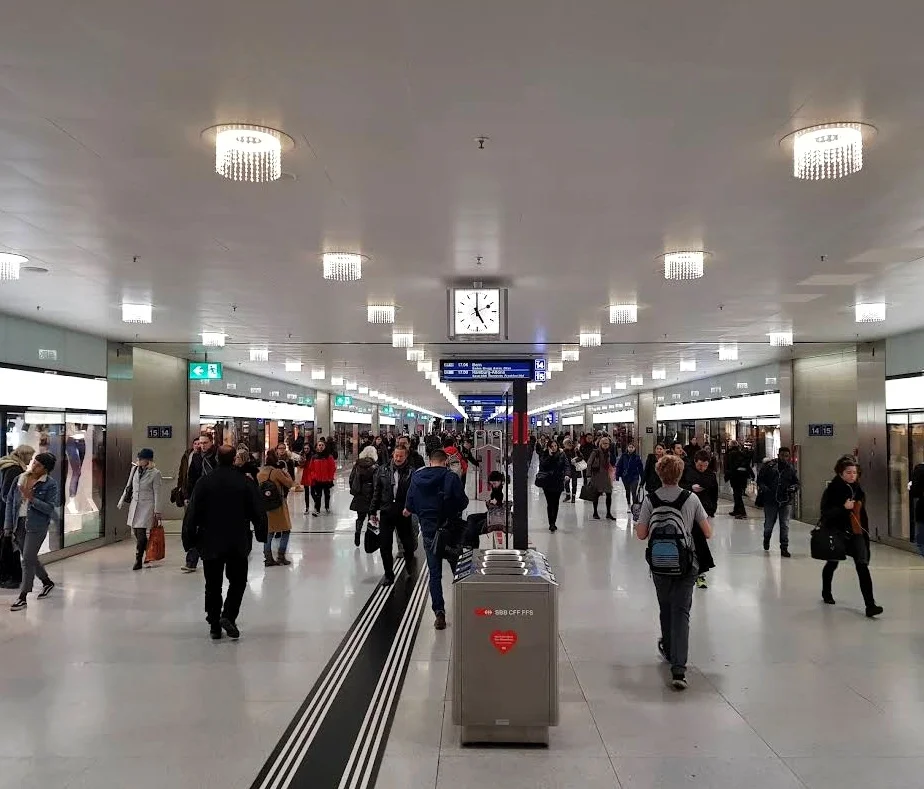
Exclusive deals & discounts from Switzerland, only for our community.
Join Today!
Switzerland offers one of the most efficient, scenic, and perfect railway systems in the world.
To make the most of your Swiss train experience, it’s helpful to know a few key tips and tricks.
In this article, I’ll share the 17 top tips to ride Swiss trains, ensuring a smooth, enjoyable, and memorable journey.
So, hop on and discover the wonders of Switzerland by train!

The SBB Mobile App is the one app that you need in Switzerland. This is a Swiss public transportation system app.
It works for trains, buses, trams, boats, gondolas, and everything Swiss public transportation offers.
It is really useful and it gives you information about your route, where to change, at what time, and on which platform.
This is the best way not to get lost. Use this SBB Mobile App.
The SBB Mobile App is available for both iOS and Android devices, and you can download the app from the App Store and Google Play Store.

The fact that you can actually send some pieces of luggage from one train station to another or even to a hotel for a fee with the Swiss trains is impressive.
This is actually from station to station. It will be CHF 12 per piece of luggage. So, this is actually not bad at all.
It’s going to take two days, so if you drop it today, it will be the day after tomorrow that you’ll receive it.
If you are able to plan, for example, you have lots of hiking gear for Interlaken and you’re going to spend a few days in Geneva, you can actually make this work.
If you need it on the same day, then it’s going to be complicated, but that’s something to note.
Both Classes provide reliable and comfortable rides, but there are distinct differences between them.

First class offers greater legroom and wider seats compared to second class, which gives you a more comfortable journey, especially on longer trips.
First Class carriages are generally less crowded, which ensures a more relaxed atmosphere with fewer passengers.
But first class tickets are more expensive than second class.

The second class is also comfortable but with less legroom and narrower seats compared to the first class.
Yet, They are well-suited for short or medium-length journeys. The atmosphere in the second class is busier and livelier, which might not be preferable for everyone.
Also, second class tickets are significantly cheaper than first class. If budget is a primary concern, go for the second class.

Also, on the topic of first and second class, you have the possibility in Switzerland to purchase upgrades.
So, you can have a Swiss travel pass that is valid for second class, but if you want to ride the Glacier Express in first class, you can do this.
You need to purchase an upgrade on the SBB app either for a point-to-point ticket or for the whole day.

Some of you may be curious about seat reservations.
I assure you that you virtually never need seat reservations unless you’re taking one of the panoramic trains, which is mandatory.
So, if you take the Glacier Express, Bernina Express, or Golden Pass, you need to have a seat reservation.
But for any other train, even a long-distance one from Zurich to Geneva, you just get on and sit in your reserved ticket fare class.
It is super simple and really easy to do in Switzerland.

Many of you will come to Switzerland and will utilize either the Swiss Travel Pass or the Swiss Half Fare Card. Each offers different benefits and is suited to different types of travelers.
The Swiss Travel Pass allows unlimited travel on consecutive days throughout the Swiss travel system network.
It’s available for 3,4,6,8, & 15 consecutive days. You can get free entry to over 500 museums and up to 50% discount on other leisure activities with this pass.
If you are planning to use public transportation extensively, the Swiss Travel Pass is ideal for you. It offers the simplicity of a single pass for all travel needs.
Prices vary depending on the duration of the pass:
Time | 1st Class | 2nd Class |
3 days | CHF 389 | CHF 244 |
4 days | CHF 469 | CHF 295 |
6 days | CHF 602 | CHF 379 |
8 days | CHF 665 | CHF 419 |
15 days | CHF 723 | CHF 459 |
Buy your Swiss Travel Pass here
The Swiss Half Fare Card offers discounts of up to 50% on journeys by trains, boats, buses, and most mountain railways, gondolas, and panoramic routes.
It’s valid for one month, and you have the flexibility to use it. No need to travel on consecutive days; you pay half price each time you buy a ticket.
If you are planning to take only a few trips or stay for a longer period without traveling every day, it’s perfect for you.
The Swiss Half Fare Card costs CHF 120 (1 month).
You need to get a ticket before you step into the train or at least before the train departs.
Remember, you cannot buy a ticket after the train starts. So, make sure to have your valid ticket.
And this is where the Swiss Travel Pass is great because you can basically ride anywhere, at any time in Switzerland during the days of validity.
Therefore, you don’t need to think about buying a ticket.
However, if you are using a Swiss Half Fare Card, always make sure that you buy these tickets in advance.

If you’re worried about having a seat, you can see on the SBB app how full the train is.
They predict that and give you an update at any time of the day. There’s an icon from 1 to 3 little people, and they have it for both first class and second class.
If the 3 icons are red, that means the train will be highly occupied.
If you think a train is going to be totally packed, you could take the next one, or you can upgrade and sit in first class.
Just make sure you have that seat.

For some reason, if you can not use the SBB app, which is great for purchasing tickets, then you can always use the machines at the train stations.
All train stations have the machines. The machine interfaces are always in English as well as in French and German.
So, if you don’t have the SBB app or can’t use the app, then buy a ticket from the machine.

If you have your luggage with you and you need to store it for whatever reason, well, the good news is all train stations virtually have lockers available to you, which are self-service lockers.
You can pay for them with coins or sometimes with cards, and they are relatively inexpensive, up to CHF 7 or 8 for very big ones.
You will get a key or a little code depending on the system. You can leave all of your luggage at the train station and go about your day.

If you don’t want to drag your luggage up the stairs, or you’re with someone who needs a little bit of assistance, or if you’re with a toddler and have a stroller, there are ramps and elevators in almost all of the train stations.
The reason I’m pointing it out is often when you are in the train station in Switzerland, the way they will be set up is to get to the same platform from underground, one side will have stairs, and one side will have ramps.
So, just check if you go and see the stairs. You don’t have to carry the stroller up.
You can look across the way, and often there is a ramp or elevators that you can take up.

In Switzerland, the platforms are huge because the trains can vary in length.
So, if you are going from Zurich to Geneva, those trains will be massive. They will be the entire length of the platform, but the smaller ones are going within Zurich.
You want to make sure you’re positioned in the right spot on the platform. What you do first is look up at the platform and you will see signs that’ll be sector letters and it’ll say A, B, C, D.
From those letters, you’ll know where you are standing, and you will also see screens that will have a map of the train and information about where it will be on the tracks.
It’ll tell you where the first and second class wagon will be. It will also tell you what sectors of the platform to expect them in.
So, let’s say you are standing in sector A and the train is going to be only in sectors C and D, make sure to get down there before the train comes because you’ll be kind of sprinting down to catch the train.

Here are a few things I would recommend: looking at the SBB app before changing and see which platform you are arriving at and which platform you need to go.
This gives you a suggestion of the distance that you need to go and you’ll have a clear plan.
I would say in general, in Switzerland, you can count on maybe 5 minutes maximum to change.
The exception for me is probably Zurich main station, where I would count maybe 10 minutes to change because it is a bit more complicated on different levels.
So, the Zurich main station is the one I would take more time to change trains.

If you’re someone who just wants to rest and relax, or if you have a loud party with lots of kids, there’s a different wagon option for you on the larger inter-city trains.
On the big inter-city trains, there will often be a family wagon, and the family wagon is more than just a place where you can be more comfortable with noise.
Sometimes they’ll even have little playgrounds like slides. On the other end of the spectrum, if you are someone who had a long day and likes to relax, there are quiet wagons also.
So, make sure your noise level is respective to where you are on the train. If you are in the quiet wagon with young children, the Swiss people will likely not be so welcoming to you there.
Just check that out and make sure you’re in the right spot.

Many of you are coming to Switzerland for longer periods of time and you’re likely going to be carrying quite a bit of luggage.
So, there are a few different places on the trains where you can store your luggage.
For smaller carry-on items, there’s an overhead rack that you see on an airplane, relatively that size but it doesn’t have the closure.
Also, in between the sections of seats is another place where you can put your smaller times.
For larger items, usually on both ends of the train wagon, there will be racks where you can put your larger items.
If you have skis or bikes, there are some racks to put them, and you will see those racks labeled on the train.

There is a specific system in Swiss trains to indicate bathrooms. You have the WC logo that will be on one side of the wagon.
These logos will tell you where the closest bathroom is and they will always either be green or red to say if that bathroom is free or occupied.
From personal experience, they are very clean for being on a train. So, if you’re on a long journey and someone who has a little bit of bathroom anxiety, don’t worry!
You have a nice clean bathroom option on the Swiss train.

In Switzerland, all shops are closed on Sundays.
However, on Sundays, shops and supermarkets will be open in all of the train stations and airports in Switzerland.
If you need to do your shopping and you’re in a train station on Sunday, then grab the necessary things because they won’t be open elsewhere.
It’s a great idea to check the specific opening hours of the shops in the train station you are visiting.

I’m a passionate travel writer and food enthusiast with a deep love for Switzerland. With years of experience exploring the country’s breathtaking landscapes, top hotels, and finest restaurants, I share insider tips, must-visit destinations, and authentic Swiss experiences on Swiss Sage.
Exclusive deals & discounts from Switzerland, only for our community.
Join Today!
© Swiss Sage 2025